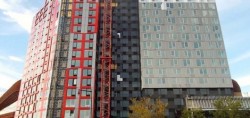A 32-story, 363-unit apartment tower composed of prefabricated, modular parts with a steel frame has opened in Brooklyn, NY, and purports to be the tallest modular building in the world, The Wall Street Journal reported. The project is located at the 22-acre, 6,430-unit Pacific Park Brooklyn development.
A project of Forest City Ratner Cos.’ Modular construction business, which it shed earlier this year, 461 Dean offers half of its units at market rate and the other half to low- to moderate-income renters.
The building joins a spate of other smaller-scale projects in New York City that have used prefabricated modular construction, such as the 28-unit Stack multifamily building in Manhattan, according to The Journal.
The opening of 461 Dean shows the continued inroads made by prefabricated modular construction in helping to alleviate the affordable housing crisis in the nation’s largest cities. By focusing most of a project’s construction and installation processes in a factory setting, its completion timeline can be reduced by up to 70% and labor costs can be lowered considerably.
Forest City Ratner sold off its modular business — to former executive Roger Krulak who now runs it as Full Stack Modular — after having previously announced plans to construct all 15 buildings set for Pacific Park using the method. Upon announcing the divestment, the company also said it would complete the remaining buildings set for the Brooklyn development using conventional construction methods. Construction at 461 Dean was mired by delays, and its four-year construction timeline has made it one of the city's longest-running projects of its size.
Experts say modular prefab accounts for just 2% to 5% of the overall construction industry, and its growth so far has been slow. Still, prefab advocates say the outlook remains positive. "Some of the larger owners out there are starting to realize there are efficiencies there, but you have to be doing a certain amount of volume for these kinds of strategies to pay off," e-Builder president and CEO Ron Antevy told Construction Dive earlier this year.
In addition to multifamily residential construction, the method has also been utilized for healthcare projects, where portions of a project, such as patient rooms or examination areas, may need to be replicated hundreds of times for a single job.
Original link - Construction Dive









